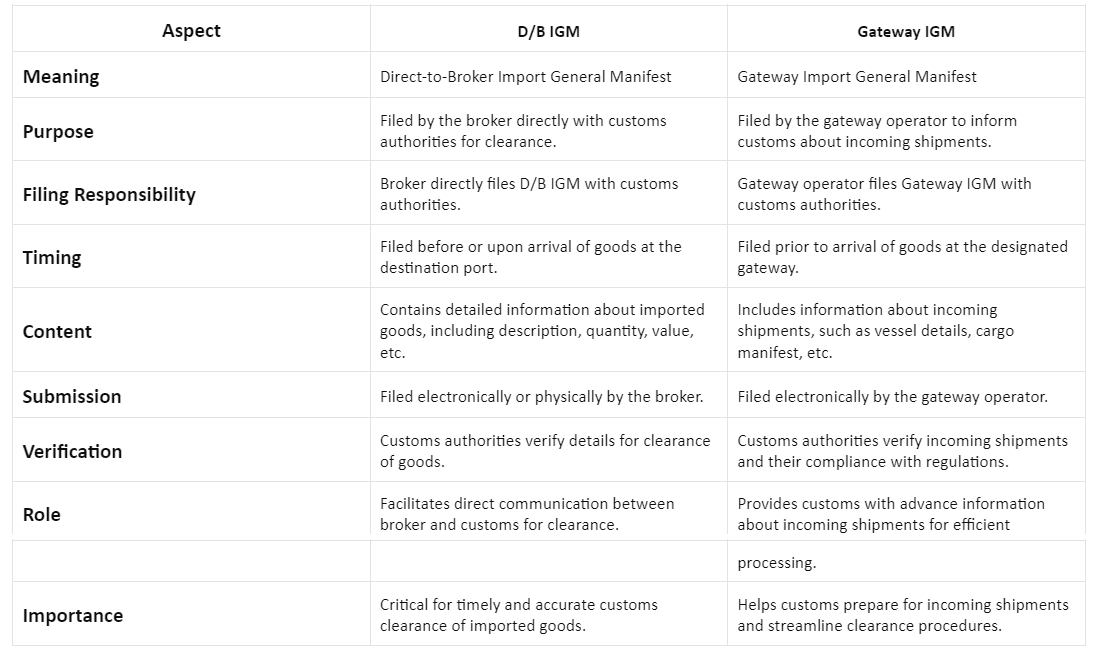Before goods make their way to their import destination, there’s an essential step that needs to happen, which is filing a document with the customs office. This document is like the gatekeeper for the goods, ensuring everything is in order before they’re allowed to enter the country.
Once the goods arrive, customs checks this document thoroughly to make sure all the details are accurate. It’s a crucial process because it helps prevent any misunderstandings or problems with the import.
This document is formally known as the Import General Manifest, or IGM for short. Think of it as the official paperwork that gives the green light for the goods to pass through customs smoothly. So, next time you’re waiting for an import, just know that the IGM is working hard behind the scenes to make it happen.
What is the Import General Manifest?
The Import General Manifest (IGM) is a crucial document filed with the customs authorities at the destination port before the arrival of goods. It contains detailed information about the imported cargo, including the description of goods, quantity, value, country of origin, and other pertinent details.
Customs officials use the IGM to verify the accuracy of the information provided and to facilitate the clearance process. It ensures compliance with import regulations and helps prevent smuggling, misdeclaration, or other illegal activities related to imports. Essentially, the IGM serves as a vital tool for customs authorities to monitor and regulate the flow of goods entering a country through its ports.
Who Uses Air IGM?
The Air Import General Manifest (IGM) is utilized by either the airlines transporting the shipment or the appointed broker. It must be submitted against the master airway bills through ICEGATE (Indian Customs and Central Excise Electronic Commerce/Electronic Data Interchange).
Customs authorities rely on the Air IGM to conduct inquiries and verify the accuracy of the provided information. It serves as a crucial document for ensuring compliance with import regulations.
Upon arrival, the goods are meticulously inspected alongside the Air IGM by the authorities to identify any errors or discrepancies. This process helps maintain the integrity of the import process and prevents potential issues with the clearance of goods.
Filing Air IGM
- An Air Import General Manifest (IGM) is filed through ICEGATE, an online portal managed by the Central Board of Indirect Taxes and Customs.
- ICEGATE offers e-filing services for importers, enhancing convenience in the filing process.
- The airline or its agent is responsible for filing the Air IGM against the master airway bill, ideally 24 hours before the shipment’s arrival at the destination.
- When filing, details such as Flight Number, Flight Date, and Flight Time are essential to include.
- Carriers must ensure all shipment details are accurately filled out on the Air IGM form prior to the shipment’s arrival at the destination port.
- Once filed and reviewed, the document is forwarded to the customs department of the respective country.
- Customs officials require supporting documents for verification after the Air IGM is filed.
- Accuracy is crucial; all information provided in the Air IGM and its supporting documents must be error-free.
- Upon verification of the document details, approval for cargo release is granted by the customs authorities.
Enquiring About Air Import General Manifest (IGM) on ICEGATE
To inquire about your Air IGM on ICEGATE, follow these steps:
- Enter the destination location.
- Provide the Air Waybill number associated with your shipment.
- Complete the captcha verification to ensure security.
Once you’ve filled in these necessary fields, you can proceed to inquire about your Air IGM. This process allows you to easily access and track important information regarding your shipment’s status and clearance procedures.
D/B IGM and Bill of Entry
The comparison below highlights the key differences between Import General Manifest (IGM) and Bill of Entry, emphasizing their respective roles, timing, content, submission process, and importance in the customs clearance process.

D/B IGM and Gateway IGM
This comparison below outlines the differences between D/B IGM (Direct-to-Broker Import General Manifest) and Gateway IGM (Gateway Import General Manifest), highlighting their respective meanings, purposes, filing responsibilities, timing, content, submission process, verification, role, and importance in the customs clearance process.

In summary, knowing about the Import General Manifest (IGM) process is super important for smooth importing. From filing the Air IGM to making sure everything’s accurate, paying attention to details helps avoid delays and stay compliant. Understanding different types of IGMs, like D/B IGM and Gateway IGM, shows how importing works. When we understand these steps, we can handle international trade confidently, making customs clearance easier and keeping goods flowing smoothly across borders.



